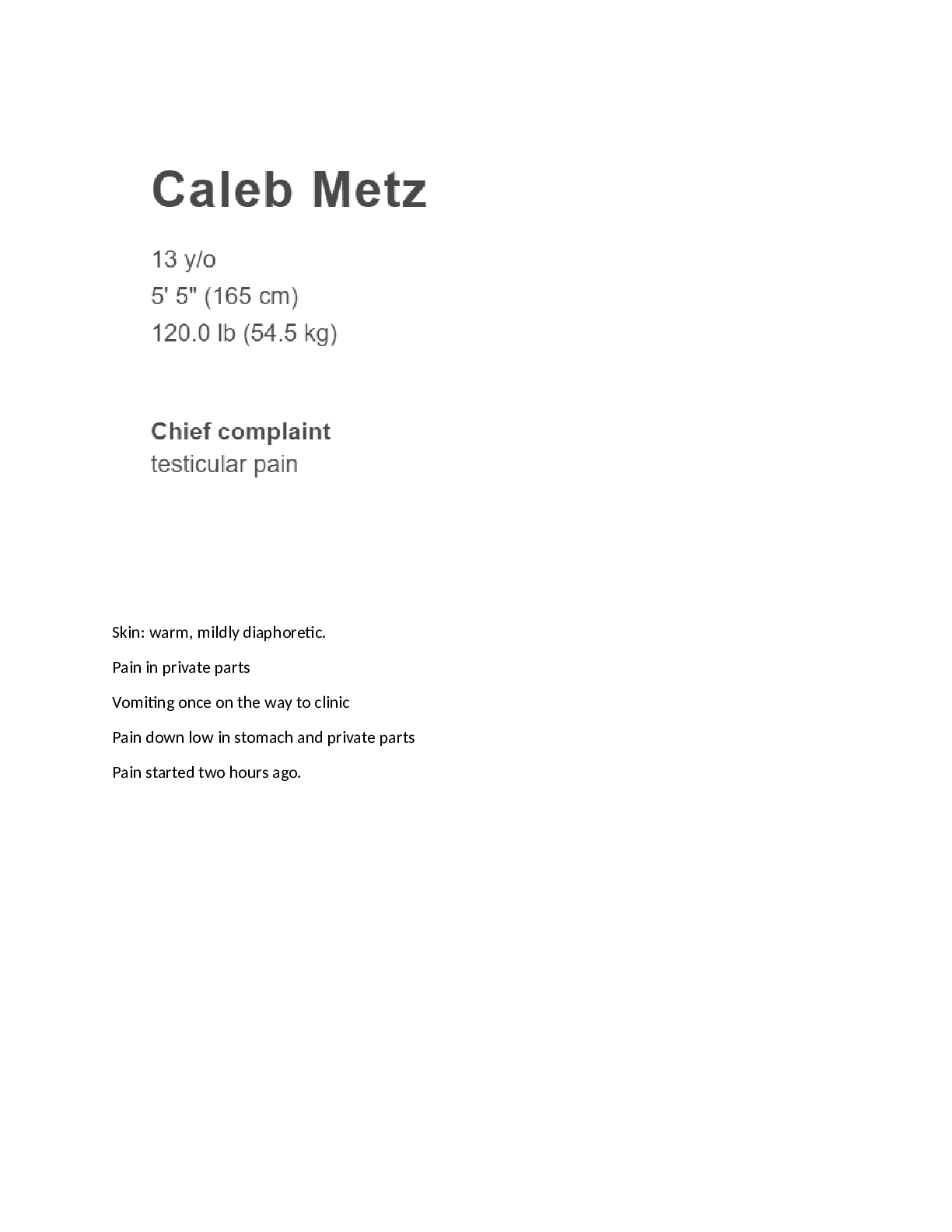Anatomy > CASE STUDY > BSC 2346L module 7 case study_Scott, a 37-year-old elementary teacher (answered) Latest 2021 (All)
BSC 2346L module 7 case study_Scott, a 37-year-old elementary teacher (answered) Latest 2021
Document Content and Description Below
BSC 2346L module7 case study. Question 1 Scott, a 37-year-old elementary teacher, is seeing his general practitioner for complaints of general weakness, especially in his lower extremities. He has a... lso been feeling very fatigued lately and has trouble keeping up with his students throughout his work day. His physician notes that he has lost a significant amount of weight in the last 6 months. Scott reports that even simple tasks, such as brushing his hair and getting dressed, can seem like a chore. He has trouble climbing stairs because of his weakness and notices that his speech is slurred, especially at the end of the day. Scott’s physician uses a tongue depressor during his physical examination and Scott begins to gag and has difficulty swallowing. His physician notes muscle wasting and abnormal spasticity in upper and lower extremities bilaterally. All reflexes are normal except the Babinski reflex. Scott’s toes fan out when the sole of his feet are stroked with the reflex hammer. Scott’s symptoms are primarily related to problems with: Motor neurons Neurons of the autonomic nervous system only Sensory neurons Both sensory and motor neurons Question 2 Because Scott’s symptoms are progressively getting worse over a period of several months, we can rule out which of the following diagnoses? Traumatic spinal cord hemisection Muscular dystrophy Amyotrophic Lateral Sclerosis Multiple Sclerosis Question 3 Scott’s physician believes he may have ALS. Briefly describe this condition in your own words. Question 4 Which of the following is NOT an early symptom of ALS? Loss of balance Difficulty swallowing Leg weakness Fatigue Question 5 What are the major differences between ALS and MS, physiologically? Describe any pathological differences you find in your research. Question 6 Scott has a positive Babinski reflex. What is the significance of this? What does a positive Babinski reflex mean in adult patients? Question 7 ALS stands for Amyotrophic Lateral Sclerosis. What does “amyotrophic” mean? What is happening to the body (physiologically) if it is experience “amyotrophic” changes? ALS stands for Amyotrophic Lateral Sclerosis. What is the word “lateral” referring to in this case? The symptoms only affect one side of the body. The neurodegeneration affects the lateral columns of the spinal cord. The neurodegeneration affects the lateral portion of the cerebrum. The disease only affects the lateral part of the body. Question 9 The motor neurons affected by ALS are found in the spinal nerves and peripheral branches of those spinal nerves only. True False Question 10 Which of the following statements regarding ALS is true? The average survival time for a patient diagnosed with ALS is 20-25 years post-diagnosis. The familial type of ALS is the most common and accounts for 80% of all ALS cases in the U.S. ALS cannot be cured, but medication can stop the progression and sometimes reverse the effects of ALS. Diagnosing ALS can involve a spinal tap, electromyography, X-rays, MRI, muscle and nerve biopsies, and blood tests. Question 11 Russell is 72 years old and is still working part-time as a professor. He has noticed some arm and hand shaking in the past year, but assumed it must be related to low or high blood sugar levels because he has had some issues with that in the past. However, the shaking/twitching has become more consistent lately and does not seem to be correlated with his diet. Russell’s doctor said that the stress of his job could be the problem, so he took the entire summer off from teaching. When he returned to work in the fall, Russell and his students noticed that his handwriting has become nearly illegible. Drinking a cup of coffee without spilling had also become a challenge. Russell returned to his doctor, who performed a physical exam and a few tests. Here are the notable results: shuffling gait, mild bradykinesia, mild voice tremor, intermittent rigidity of the limbs, and normal EEG. If Russell is having symptoms in his upper extremities, lower extremities, and his speech is slurred, which of the following body regions is most likely experiencing a pathology? Brain and spinal cord Spinal nerves Cranial nerves Peripheral nerves Question 12 Russell’s physician suspects that he may have Parkinson’s disease. List at least two other diagnoses that could fit Russell’s history and test results. Shaking or tremor, bradykinesia, stiffness/rigidity of the arms, legs, or trunk. Progressive supranuclear palsy and multiple system atrophy. Trouble with balance and possible falls and trouble moving. Question 13 Which of Russell’s physical exam findings could be related to a brain condition? Question 14 Shuffling gait is often associated with Parkinson’s disease. Which of these symptoms is NOT another common sign of Parkinson’s disease? Babinski reflex Rigidity Bradykinesia Facial masking Question 15 Russell’s physician decides to follow-up with an MRI. If he does have Parkinson’s disease, his MRI may show degeneration in which part of the brain? Frontal lobe Substantia nigra Wernicke’s area Corpus callosum Question 16 Parkinson’s disease involves the loss of a particular neurotransmitter. Which neurotransmitter is involved and how is it associated with the motor symptoms of Parkinson’s disease? Question 17 Which of the following is NOT a treatment option for Parkinson’s disease? Deep brain stimulation Antidepressant medications Levodopa Radiation Question 18 If Russell is diagnosed with Parkinson’s disease and chooses not to pursue treatment, what is his prognosis Question 19 What does the term “neurodegenerative” mean? Briefly describe this term in your own words. (Do not copy a definition.) Question 20 Which of the following statements is true regarding Parkinson’s disease? It is possible to reverse the effects of Parkinson’s disease. The loss of neurons is often accompanied by the necrosis of astrocytes and an increase in microglia. Parkinson’s disease is typically diagnosed before 40 years of age. Brain imaging typically shows degeneration of neurons in the temporal lobe. [Show More]
Last updated: 2 years ago
Preview 1 out of 6 pages

Buy this document to get the full access instantly
Instant Download Access after purchase
Buy NowInstant download
We Accept:

Reviews( 0 )
$15.00
Can't find what you want? Try our AI powered Search
Document information
Connected school, study & course
About the document
Uploaded On
Apr 21, 2021
Number of pages
6
Written in
Additional information
This document has been written for:
Uploaded
Apr 21, 2021
Downloads
0
Views
126















